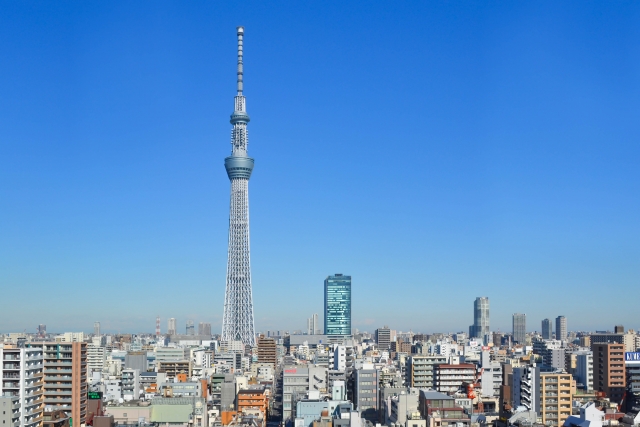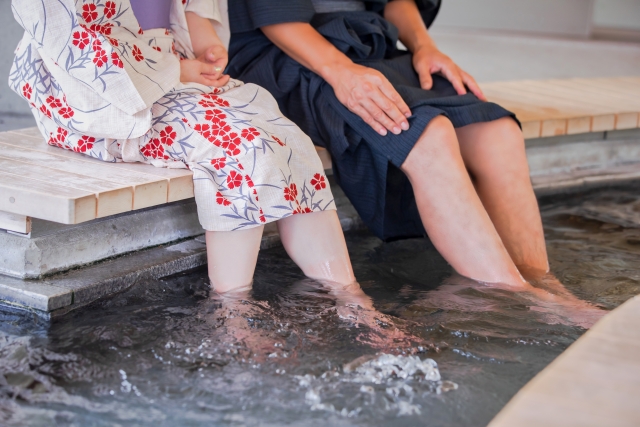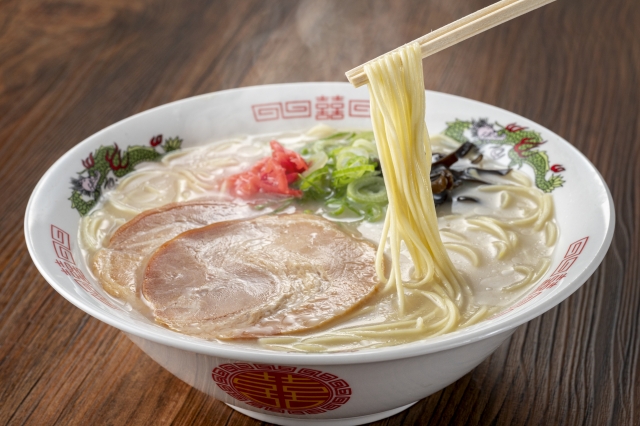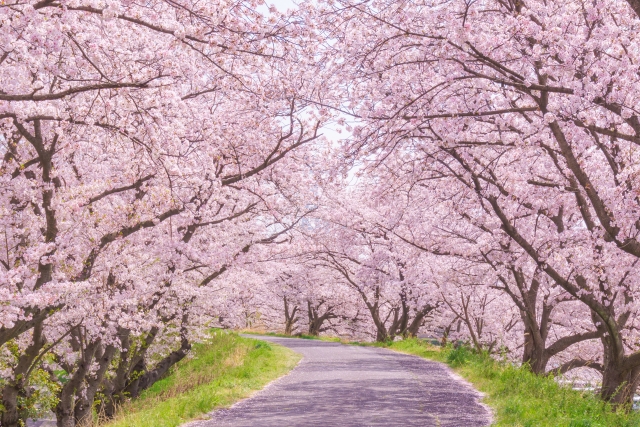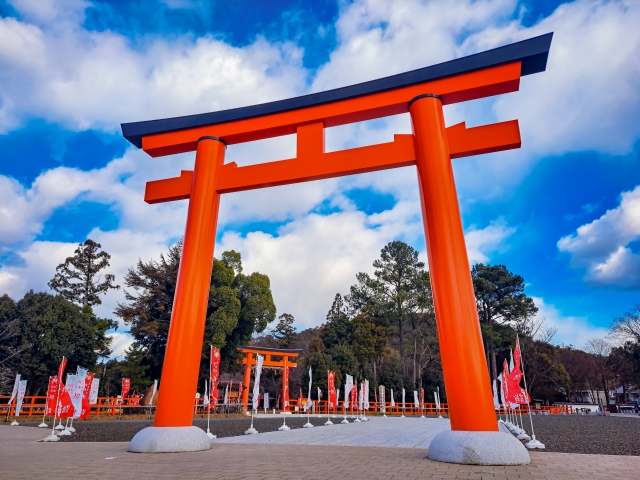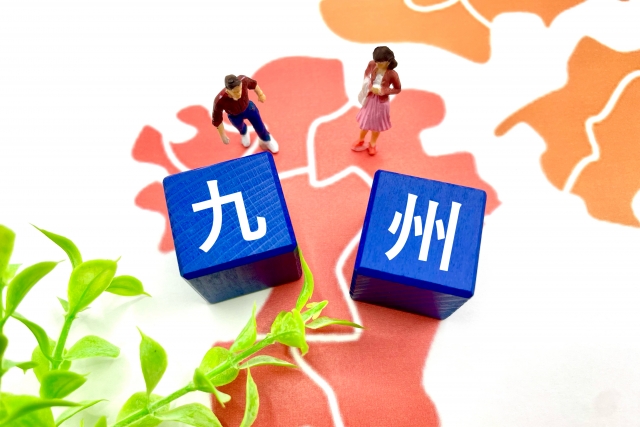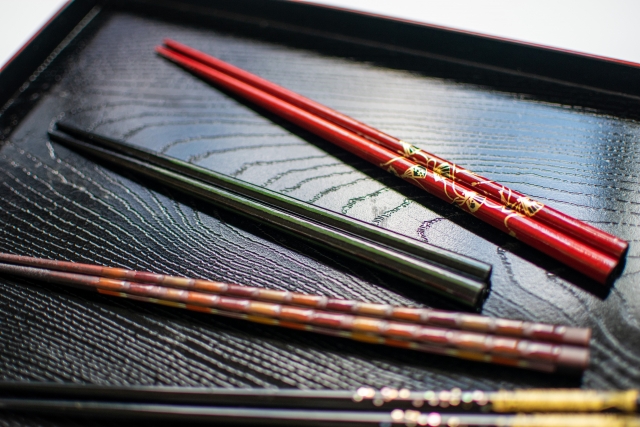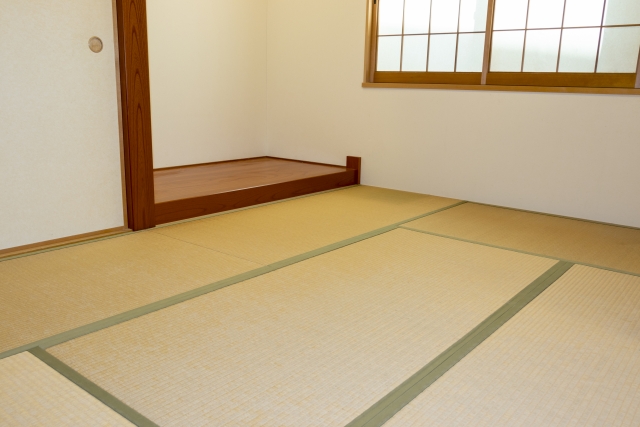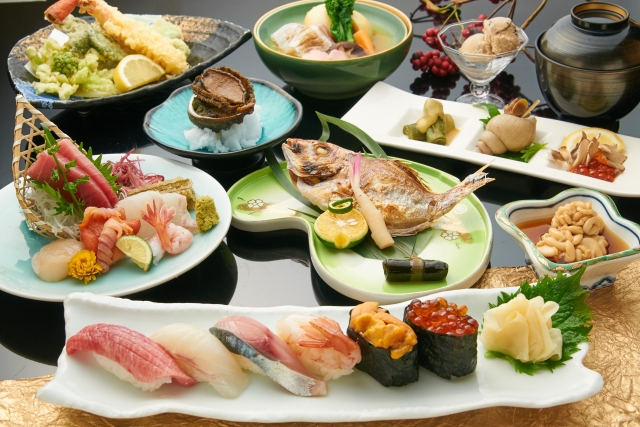Dango or dumplings are made by rolling grain flour with water or hot water, and steaming or boiling it. The most famous dango are Anko, Kinako, and Mitarashi dango, which are generally eaten with about four pieces on a skewer. Dango has been eaten since the 800’s (Heian period) and is still loved by everyone of all ages. Today, it is a food of good luck that is enjoyed all year round but is served as offferings or during festivals, and other events.
 Mochi, on the other hand, is made by steaming glutinous rice and pounding it with a pestle. When the rice is steamed, the grains of the rice remain and are not in powder form. As the rice is pounded, the grains disappear and a chewy rice cake is produced. I mentioned that dango have been eaten since 800 (Heian period), but mochi have been eaten since over 2000 years ago (the late Jomon period).
In other words, dango is defined as dumplings made of “powder” and mochi as rice cakes made of “grains”.
Mochi, on the other hand, is made by steaming glutinous rice and pounding it with a pestle. When the rice is steamed, the grains of the rice remain and are not in powder form. As the rice is pounded, the grains disappear and a chewy rice cake is produced. I mentioned that dango have been eaten since 800 (Heian period), but mochi have been eaten since over 2000 years ago (the late Jomon period).
In other words, dango is defined as dumplings made of “powder” and mochi as rice cakes made of “grains”.

 One of the most classic and popular dango in Japan is the “Mitarashi Dango”. Mitarashi is a soy sauce-based sauce that tastes both salty and sweet, and has been loved by people as a Japanese sweet since ancient times. Some are baked before putting some mitarashi sauce on, but I prefer the baked ones because they are more savory. They are easiest to find in supermarkets and convenience stores, aren’t they?
The name comes from the fact that they were sold at the Mitarashi Festival, a festival held at Shimogamo Shrine in Kyoto.
One of the most classic and popular dango in Japan is the “Mitarashi Dango”. Mitarashi is a soy sauce-based sauce that tastes both salty and sweet, and has been loved by people as a Japanese sweet since ancient times. Some are baked before putting some mitarashi sauce on, but I prefer the baked ones because they are more savory. They are easiest to find in supermarkets and convenience stores, aren’t they?
The name comes from the fact that they were sold at the Mitarashi Festival, a festival held at Shimogamo Shrine in Kyoto.
 Anko dango is another one of the most popular dango in Japan. It is not too much to say that dango is a set for Anko. Dango and Anko go together perfectly. This is the difference between dango and white rice, right? It’s not like eating white rice and red bean paste together, but the elasticity and chewiness of the dango makes it a terrific match for red bean paste.
Anko dango is another one of the most popular dango in Japan. It is not too much to say that dango is a set for Anko. Dango and Anko go together perfectly. This is the difference between dango and white rice, right? It’s not like eating white rice and red bean paste together, but the elasticity and chewiness of the dango makes it a terrific match for red bean paste.
 Kinako dango is another kind of dango that you should try at least once. Mitarashi, Anko, and Kinako are the three most popular dango in Japan.
Kinako dango is another kind of dango that you should try at least once. Mitarashi, Anko, and Kinako are the three most popular dango in Japan.
 Soy sauce dango are dango seasoned with soy sauce, and are sometimes called just “yaki dango” or “dango. In some regions, it is also considered the same as the “Midarashi Dango” introduced above.
Soy sauce dango are dango seasoned with soy sauce, and are sometimes called just “yaki dango” or “dango. In some regions, it is also considered the same as the “Midarashi Dango” introduced above.
 Norimaki dango is a soy sauce dango with nori (seaweed) on top or wrapped around it. It is sometimes called “isobeyaki dango” because of its similarity to isobeyaki, where rice cakes are baked, dipped in soy sauce, and wrapped in nori.
Norimaki dango is a soy sauce dango with nori (seaweed) on top or wrapped around it. It is sometimes called “isobeyaki dango” because of its similarity to isobeyaki, where rice cakes are baked, dipped in soy sauce, and wrapped in nori.
 Sanshoku dango is very popular because of its unique appearance. Also called hanami dango, they are often seen in Japan during the cherry blossom season, which blooms around spring.Nowadays, these colored dango are colored with dyes and the taste of each one will be almost the same, but traditional shops still use natural ingredients. Pink is traditionally dyed with red shiso, and green is traditionally mugwort.
Sanshoku dango is very popular because of its unique appearance. Also called hanami dango, they are often seen in Japan during the cherry blossom season, which blooms around spring.Nowadays, these colored dango are colored with dyes and the taste of each one will be almost the same, but traditional shops still use natural ingredients. Pink is traditionally dyed with red shiso, and green is traditionally mugwort.
 These dumplings are topped with zunda made from edamame. They are very popular in the Tohoku region.
These dumplings are topped with zunda made from edamame. They are very popular in the Tohoku region.
 As the name implies, yomogi dango is made from yomogi(mugwort), which has a mild green, grassy taste and a unique texture, making it a dango that can be liked or disliked.
As the name implies, yomogi dango is made from yomogi(mugwort), which has a mild green, grassy taste and a unique texture, making it a dango that can be liked or disliked.
 As I mentioned above, anko dango is often divided into two types, tsubu-an dango and koshi-an dango. This is because there are different likes and dislikes. Koshi-an is especially popular among small children.
Koshi-an dango is more popular, especially among small children, but as people grow older, some people prefer tsubu-an, which is more satisfying to eat.
As I mentioned above, anko dango is often divided into two types, tsubu-an dango and koshi-an dango. This is because there are different likes and dislikes. Koshi-an is especially popular among small children.
Koshi-an dango is more popular, especially among small children, but as people grow older, some people prefer tsubu-an, which is more satisfying to eat.
 The sweet sesame dango that is often served in Chinese desserts is also popular in Japan.
They are deep-fried dango filled with red bean paste and sprinkled with sesame seeds.
The sweet sesame dango that is often served in Chinese desserts is also popular in Japan.
They are deep-fried dango filled with red bean paste and sprinkled with sesame seeds.
 If you are in Japan, you can easily get dango. You can usually find them anywhere, including stores in shopping streets, convenience stores, supermarkets, and stalls at festivals.
If you are outside of Japan, you will likely find dango sold in Japanese supermarkets. But dango are surprisingly easy to make, so it’s fun to try making them yourself!
If you are in Japan, you can easily get dango. You can usually find them anywhere, including stores in shopping streets, convenience stores, supermarkets, and stalls at festivals.
If you are outside of Japan, you will likely find dango sold in Japanese supermarkets. But dango are surprisingly easy to make, so it’s fun to try making them yourself!
 2.Form the dough into small balls (dango).
2.Form the dough into small balls (dango).
 3.Drop the dumplings into a pot of boiling water and wait for them to float to the surface (about 5 minutes).
3.Drop the dumplings into a pot of boiling water and wait for them to float to the surface (about 5 minutes).
 4. pick up the dango from the pot.
Skewer with a wooden skewer, or if you don’t have a skewer, enjoy with a spoon!
4. pick up the dango from the pot.
Skewer with a wooden skewer, or if you don’t have a skewer, enjoy with a spoon!
 ★Points
When the boiled dumplings start to float to the surface, pick them up quickly.
It is a tip that you don’t take time to cook.
They taste best when freshly made, so I recommend making them just before eating.
★Points
When the boiled dumplings start to float to the surface, pick them up quickly.
It is a tip that you don’t take time to cook.
They taste best when freshly made, so I recommend making them just before eating.
 Ingredients:
2 tablespoons (15ml x 2) soy sauce
2 tablespoons (15ml x 2) mirin
4 tablespoons (15ml x 4) sugar
2 tablespoons (15ml x 2) potato starch
150cc water
5.Mix together the ingredients for the sauce (see above).
6.Heat over low heat until thickened.
What? I know some of you may be thinking, “Is that all?”
Yes, that’s it!
If you like it sweeter, you can adjust it by adding more sugar and mirin!
Ingredients:
2 tablespoons (15ml x 2) soy sauce
2 tablespoons (15ml x 2) mirin
4 tablespoons (15ml x 4) sugar
2 tablespoons (15ml x 2) potato starch
150cc water
5.Mix together the ingredients for the sauce (see above).
6.Heat over low heat until thickened.
What? I know some of you may be thinking, “Is that all?”
Yes, that’s it!
If you like it sweeter, you can adjust it by adding more sugar and mirin!

Contents
Aren’t Dango and Mochi(rice cakes) the same thing?
Dango and mochi are both made of rice. They also have the same chewy texture. Many people think that they are the same thing, just different in shape, but there is a clear difference. The raw material for dango is rice. The rice is ground into a powder and kneaded with warm water or water. The kneaded mixture is then rolled into dango-sized balls and boiled or steamed. Dango is the result of putting the powder together.Dango flavors and types
There are many types of dango with many toppings, but the dango themselves are not flavored and taste like white rice with elasticity and texture. Therefore, instead of eating them as they are, they can be eaten with a variety of toppings. This is the difference between dango and white rice, but in the case of dango, you can enjoy its soft and chewy texture, so it goes well with both sweet and salty flavors. Let’s take a look at some of the popular types of dango!Types of dango
Mitarashi Dango
Red bean paste dango (koshi-an)
Kinako dango (soybean flour dango)
Soy sauce dango
Norimaki Dango
Sanshoku Dango (Three-Color Dango)
Introducing cherry blossom viewing, which is very popular in Japan



